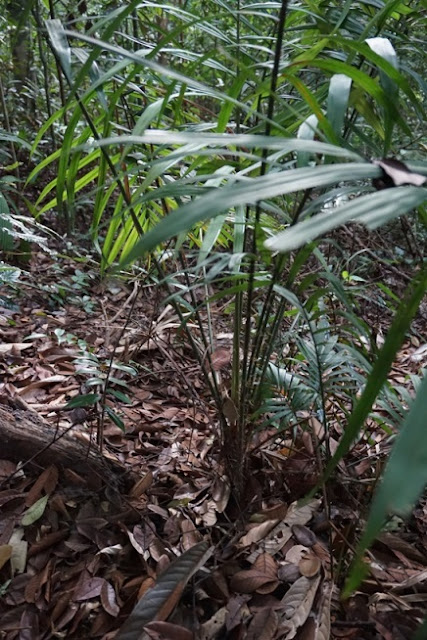By Alastair &
Ryan Liew (13 & 11 years old)
Photos by Gloria
Seow & Alastair Liew
Bukit Timah Nature
Reserve reopened its trails in October 2016 after two years of restorative
works. The NSS Kids ventured forth into its lush rainforest on 19 February
2017. Sunday mornings are popular with families out for some exercise and fresh
air.
Armed with binoculars, cameras and note pads, we eagerly lapped up the factoids
that sifu Uncle Si Guim fed us.
Right off the bat,
we came across something peculiar – a plant with many spikes on its stem,
making it look like a porcupine. After some discussion with our guide and
nature guru Uncle Si Guim, we found out that it was a rattan palm. Stripped of
its thorns, the rattan can be used to make cane furniture and the
fearsome rotan. Rattans are climbers, with hooks to help them cling onto
other plants as they grow upwards.
Careful! The rattan palm has many spines and hooks on it, and can be
used to make the infamous rotan.
We then learnt
about the different layers of the rainforest. Being the highest layer, the emergent trees stand above the canopy
layer. The canopy forms the middle tier and blocks off most of the sunlight,
allowing slivers of golden rays to reach the forest floor. The plants in the lowest level or
undergrowth are hardier and are adapted for survival in the shady zone.
We pressed on and
came across many vines dangling off the dense vegetation. We felt lucky to
see Tarzan’s vine or lianas (Entada
spiralis), which appeared thick, woody and wound around a tree. Vines
can grow up to half a metre thick. Upon further inspection, certain vines
turned out to be aerial roots. Such roots can serve different purposes
including providing clinging support for creepers.
Our attention was
drawn to a cicada moult hanging from one of the wooden safety barriers.
Depending on the species, cicadas can live underground for between two to 17
years feeding off tree roots. They only come up to the surface as nymphs
to moult into the adult winged form, undergo courtship, mate and for
females, to lay their eggs, all within the span of a week before dying. As
true insects, cicadas have piercing proboscis used to suck fluids from the
xylem of trees. Singapore has six cicada species.
Taking a few steps
forward, we felt something sticky on our faces. We had to pull off thin strands
of spider web. Looking upwards, we were astonished to find another humongous
web about half a metre in diameter belonging to the Golden Orb-Web Spider (Nephila pilipes). Spiders are
extremely sensitive. They tend to hang out in the centre of the web to better
feel the vibrations of any insect landing on it. The unlucky victims will
either be eaten immediately or “dabao’ed”
(Chinese for takeaway) in the silky web to be eaten later.
Uncle Si Guim then
pointed to the forest floor which was full of decaying matter being eaten and
decomposed by microorganisms, insects and fungi. While surveying the ground, a
huge forest cockroach suddenly emerged from a pile of leaves. My brothers and I
were petrified and remained a safe distance away. This brown forest cockroach
was well camouflaged against the rotting leaves and soil.
We spotted two
types of terrestrial ferns lining the trail – the Singapore Fern (Tectaria singaporeana) and Selaginella willdenowii, an
introduced fern ally with iridescent blue leaves that has been naturalised. Later, we found a third fern high
up in a tree. Putting our binoculars to good use, we enjoyed views of the
Staghorn Fern (Platycerium coronarium)
with attractive fronds that resemble deer antlers.
Just as the walk
was coming to an end, we stumbled across a Colugo (Galeopterus variegatus) or Flying Lemur clinging contentedly to a
tree trunk. This nocturnal mammal is able to glide a substantial distance
between trees, using a thin membrane that stretches between its limbs and tail.
What a great find! The forest walk experience was very fulfilling and we hope
that more kids and their families will join us on our next NSS Kids’ adventure!
An adorable Colugo in quiet repose up a tree near the trail.




No comments:
Post a Comment